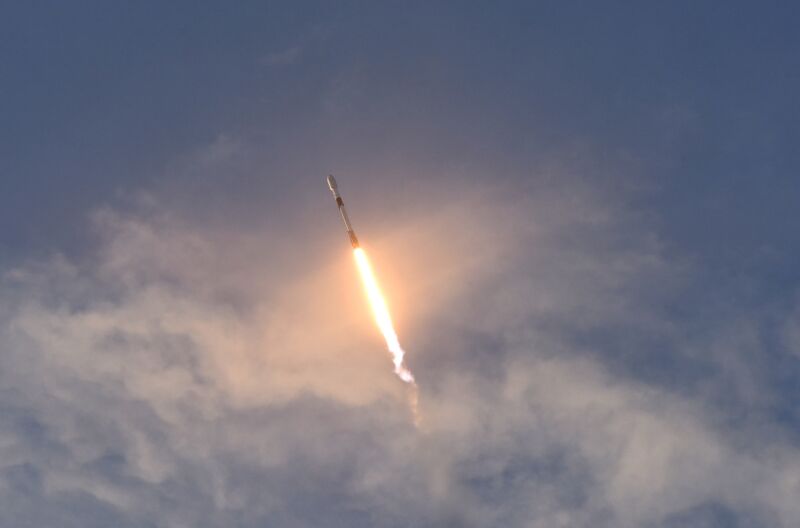
reader comments
79 with 51 posters participating
Signals from SpaceX Starlink broadband satellites can be used to pinpoint locations on Earth to within eight meters of accuracy, engineering researchers reported in a new peer-reviewed paper. Their report is part of a growing body of research into using signals from low-Earth-orbit (LEO) satellites for navigation, similar to how GPS works.
This technology won’t replace your smartphone’s map application any time soon, and this initial experiment apparently required 13 minutes of tracking six Starlink satellites to pinpoint a location on Earth. But researchers were able to achieve the locational feat without any help from SpaceX, and they say the test proves the method could be used for navigation.
“The researchers did not need assistance from SpaceX to use the satellite signals, and they emphasized that they had no access to the actual data being sent through the satellites—only to information related to the satellite’s location and movement,” an Ohio State News article said.
“We eavesdropped on the signal, and then we designed sophisticated algorithms to pinpoint our location, and we showed that it works with great accuracy,” Zak Kassas, the director of CARMEN (Center for Automated Vehicle Research with Multimodal AssurEd Navigation), a US Department of Transportation-funded center at Ohio State University, said in the article. “And even though Starlink wasn’t designed for navigation purposes, we showed that it was possible to learn parts of the system well enough to use it for navigation.”
The research was conducted by Kassas along with Joe Khalife (a postdoctoral fellow at the University of California, Irvine) and Mohammad Neinavaie (a Ph.D. student at UC-Irvine). Kassas is also a UC-Irvine professor and director of the Autonomous Systems Perception, Intelligence, and Navigation (ASPIN) Laboratory, while Khalife and Neinavaie are members of the lab. Their experiment was conducted using an antenna on the UC Irvine campus.
Kassas said his “team has used similar techniques with other low-Earth orbit satellite constellations, but with less accuracy, pinpointing locations within about 23 meters,” according to the Ohio State News article. “The team has also been working with the US Air Force to pinpoint locations of high-altitude aircraft; they were able to come within 5 meters using land-based cellular signals, Kassas said.” GPS provides signals with average errors of less than one meter.
The paper is titled “The First Carrier Phase Tracking and Positioning Results with Starlink LEO Satellite Signals” and was published last week in the journal IEEE Transactions on Aerospace and Electronic Systems. Researchers also presented their findings at an Institute of Navigation conference. Their work was funded by grants from the US Office of Naval Research, the National Science Foundation, and the Department of Transportation.
summary of the researchers’ conference presentation noted that broadband providers could change their protocols to support navigation. But the researchers argue that their own third-party approach is more viable despite requiring “more sophisticated receiver architectures.”
“[T]ailoring the existing protocols to support navigation capabilities require significant changes to existing infrastructure, the cost of which private companies such as OneWeb, SpaceX, Boeing, and others, which are planning to launch tens of thousands of broadband Internet satellites into LEO, may not be willing to pay,” they wrote. “Moreover, if the these companies agree to that additional cost, there will be no guarantees that they would not charge the users for extra navigation services. Under these circumstances, exploiting broadband LEO satellite signals opportunistically, becomes a more viable approach.”
A new algorithm
The researchers previously considered a “cognitive approach to tracking the Doppler frequency of unknown LEO SV signals” but said in their most recent paper that this method “cannot estimate the carrier phase, nor can it be adopted here since it requires knowledge of the period of the beacon within the transmitted signal, which is unknown in the case of Starlink LEO SVs.” To overcome that barrier, they “develop[ed] a carrier phase tracking algorithm for Starlink signals without prior knowledge of their structure.”
The paper said:
Little is known about Starlink downlink signals or their air interface in general, except for the channel frequencies and bandwidths. One cannot readily design a receiver to track Starlink signals with the aforementioned information only as a deeper understanding of the signals is needed. Software-defined radios (SDRs) come in handy in such situations, since they allow one to sample bands of the radio frequency spectrum. However, there are two main challenges for sampling Starlink signals: (i) the signals are transmitted in Ku/Ka-bands, which is beyond the carrier frequencies that most commercial SDRs can support, and (ii) the downlink channel bandwidths can be up to 240 MHz, which also surpasses the capabilities of current commercial SDRs. The first challenge can be resolved by using a mixer/downconverter between the antenna and the SDR. However, the sampling bandwidth can only be as high as the SDR allows. In general, opportunistic navigation frameworks do not require much information from the communication/navigation source (e.g., decoding telemetry or ephemeris data or synchronizing to a certain preamble). Therefore, the aim of the receiver is to exploit enough of the downlink signal to be able [to] produce raw navigation observables (e.g., Doppler and carrier phase).
launch tens of thousands in order to expand the broadband service’s capacity and availability. Those additional satellites would presumably also make it easier to build navigational systems of the type envisioned in the new research.
We contacted the researchers today to ask about the prospects of using Starlink satellites to get location results in something closer to real time and about how they envision LEO-based systems being used for navigation when the methods and technology are more advanced. We’ll update this article if we get a response.
Update: Kassas responded to us and provided more information on the experiment, noting in an email that “we waited 800 seconds in order to get signals from six satellites, since we’re not able yet to see six satellites above us simultaneously.” That will change as SpaceX launches more satellites. “We’re preparing another experiment for real-time position estimation in which we’ll use four Starlink satellite signals simultaneously above us,” Kassas said.
Eventually, SpaceX’s plan to launch tens of thousands of satellites “will allow for both real-time navigation and a much higher level of accuracy than what we achieved so far,” he said. In the long run, Kassas sees this as “a standalone navigation system” instead of one that merely complements GPS. “GPS signals are readily jammable and spoofable and are not reliable/usable in many environments (e.g., deep urban canyons, indoors, and under tree canopy),” he said. “We’re hoping that LEO satellites will provide an alternative resilient and accurate navigation system if/when GPS signals aren’t available or are compromised.”






